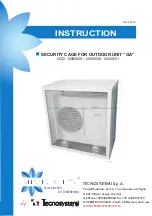
4-12
b. Installing
NOTES
1. It is important to check the compressor oil
level of the new compressor and fill if necessary.
2. The service replacement compressor is sold
without shutoff valves (but with valve pads).
These should be placed on the old compressor
before shipping. Check oil level in service
replacement compressor. If none add the
applicable amount outlined in section 1.2.b.
1. The original unloader valve must be transferred to
the replacement compressor. The plug arrangement
removed from the replacement is installed in the original
compressor as a seal. If piston is stuck, it may be extracted
by threading a socket head cap screw into top of piston. A
small Teflon seat ring at bottom of piston must be
removed.
2. Remove the high pressure switch and install on
new compressor after checking switch setting (refer to
section 4.11).
3. Install compressor in unit by reversing step 4.20.c.
It is recommended using new locknuts when replacing
compressor. Install new gaskets on service valves and
tighten bolts uniformly.
4. Attach two lines (with hand valves near vacuum
pump) to the suction and discharge service valves.
Dehydrate and evacuate compressor to 500 microns
(29.90” Hg vacuum = 75.9 cm Hg vacuum). Turn off
valves on both lines to pump.
5. Fully backseat (open) both suction and discharge
service valves.
6. Remove vacuum pump lines and install manifold
gauges.
7. Start unit and check for noncondensibles
8. Check refrigerant level and add if necessary.
9. Check compressor oil level (refer to section
4.20.2). Add oil if necessary.
10. Check compressor unloader operation.
11. Check refrigerant cycles.
4.20.2 Checking the Compressor Oil Level
a. Operate the unit in high idle cooling for at least 20
minutes.
b. Check the oil sight glass on the compressor to
ensure that no foaming of the oil is present after 20
minutes of operation. If the oil is foaming excessively
after 20 minutes of operation, check the refrigerant
system for flood-back of liquid refrigerant. Correct this
situation before adding oil.
c. Check the level of the oil in the sight glass with the
compressor operating. The correct level should be
between 1/4 and 1/2 of the sight glass. If the level is above
1/2, oil must be removed from the compressor. If the level
is below 1/8, add oil to the compressor as outlined in the
following section.
4.20.3 Adding Oil to the Installed Compressor
CAUTION
The appropriate compressor oil must be used
according to the refrigerant used in the system.
(Refer to section 1.2.b.)
Two methods for adding oil are the oil pump method
and closed system method.
a. Oil Pump Method
1. Connect an oil pump to a one U.S. gallon (3.785
liters) refrigeration oil container. Using the Robinair
compressor oil pump (Carrier Transicold P/N 14388) is
recommended.
When the compressor is in operation, the pump check
valve prevents the loss of refrigerant, while allowing
servicemen to develop sufficient pressure to overcome
the operating suction pressure to add oil as necessary.
2. Backseat suction service valve and connect oil
charging hose to port. Crack the service valve and purge
the oil hose at oil pump. Add oil as necessary.
b. Closed System Method
In an emergency where an oil pump is not available,
oil may be drawn into the compressor through the suction
service valve.
CAUTION
Extreme care must be taken to ensure the man-
ifold common connection remains immersed in
oil at all times. Otherwise air and moisture will
be drawn into the compressor.
1. Connect manifold gauge set. Place center charging
line into compressor oil container as shown in
Figure 4-11. Slowly open discharge hand valve to purge
line, then close.
2. Frontseat the suction service valve and place a
jumper wire on the low pressure switch to by-pass the
switch.
3. Start unit and pull crankcase pressure until suction
pressure gauge indicates 5 inches/hg. Shut down unit.
4. Crack open manifold valve and allow vacuum in
compressor to draw oil slowly into compressor. When
level is just above one quarter glass, close manifold valve.
Midseat the suction service valve. Remove the LPS
jumper wire.
5. Start unit and check compressor oil level.





































